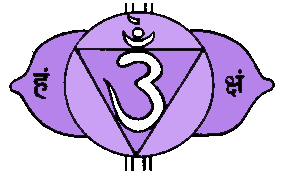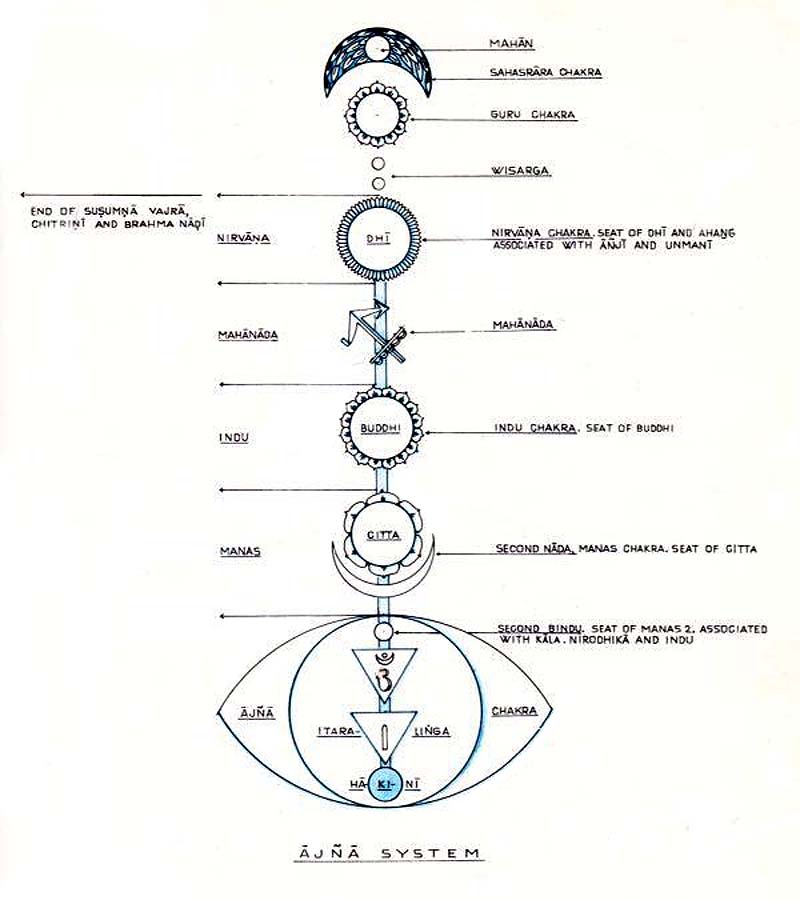|
The
Ajna Chakra.
|
|
| SEEDS OF LIGHT FREE INTERNET MAGAZINE. |
|
The
Ajna Chakra.
|
|

|
The word Ajna means "command", in the sense of the Guru's command (spiritual guidance). The Tantric Ajna or Brow chakra has two petals, is associated with the tattwa of Manas or Mind (not to be confused with the Manas-Chakra), which is beyond even the most subtle elements (although still part of embodied existence). |
It is said to be white in colour. More recently in Western occult and New Age thought the Ajna chakra has been identified with the "third eye" (eye of psychic vision), and other such concepts not found in the original Tantrika system.
 |
The
Ajna chakra
|
| Terminology | Tantric | ajna, ajita-patra, ajna-pura, ajna-puri, ajnamhuja, ajnapankaja, jnana-padma, dwidala, dwidalambuja, dwidala-kamala, dwipatra, bhru-saroruha, triweni-kamala, netra-padma, netra-patra, bhru-mandala, bhru-madhya, bhru-madhyaga-padma, bhru-madhya-chakra, bhru-mula, shiva-padma |
| Vedic (late Upanishads) | ajna, bhru chakra, bhruyugamadhyabila, baindawa-sthana, dwidala | |
| Puranic | ajna, dwidala, trirasna | |
| Position | externally, eyebrow-region | |
| Petals | number | two |
| colour | white, lightning-like | |
| Matrika-letters | on petals | two in number: Hang Kshang, arranged from right to left |
| colour | white, golden, variegated, shining | |
| In the pericarp | power Hakini | |
| Concentration form of Hakini | Hakini is moon-white, white, a mixture of white-black-red, dark-blue, or red in colour; she has one, two, three, four, five or six laces; six faces of red colour; three-eyed; six-armed, holding a book, a skull, a drum, and a rudraksha rosary, and making the gestures of granting boons and of dispelling fear; holding a rudraksha rosary, a drum, a skull, a book, and a bow, and showing the mudra; holding a skull, a spear, and a shield, and making the gestures of granting boons and of dispelling fear; two-armed; clad in red raiment with the white upper garment; seated on a white lotus | |
| In the pericarp above Hakini | a triangle | |
| Within the triangle | Itara-linga | |
| colour | moon-white, golden, red | |
| Above Itara-linga | a triangle
pranava (Ong) [=AUM] in the triangle |
|
| colour | moon-white | |
| Above pranawa-bindu | subtle manas (manas 2) (in bindu pitha) | |
| Above Manas 2 | nada (manas chakra) | |
| colour | shining white | |
 |
Although Tantra often refers to the Ajna Chakra as being located in the brow region, the implication is that this is its external manifestation, whereas the actual position is in the middle of the brain behind the brows. I differ from this conventional explanation in positing a front (descending) and an internal "Ajna" centre, as well as the back-of-the-head (ascending) centre.
In Taoism, this primary chakra in the centre of the brain is variously referred to as the Square Inch [Secret of the Golden Flower, p.25], the Heavenly Heart [Ibid], the Crystal Palace [Mantak Chia, Awaken Healing Light, pp.222-223], the Upper Tan Tien, the Original Cavity of the Spirit (Yuan Shen Shih) or the Ancestral Cavity (Tsu Ch'iao) [Taoist Yoga - Alchemy & Immortality, pp.5, 9, etc]. As with the other mid-line chakras, the Ajna is not a Chi-energy chakra, part of the ch'i circuit or microcosmic orbit, but a subtle consciousness centre, located along the laser line or Sushumni nadi that extends from the Perineal (the lower or yin polarity) to the Crown (the upper or yang polarity). It constitutes the central focus point or governing centre of the other head chakras.
The Brow Chakra corresponds to the eleventh or 772.0 Bode position. There is no planet known in this orbital, although the 20th century alchemist Frater Albertus locates "Adonis" here [The Seven Rays of the QBL, p.40]. The reason why he puts such a "personal" myth-symbol in such a position (past Pluto, the Underworld), is not stated. His association of Adonis with Pisces, and transferrence of Neptune from Pisces to Taurus [Ibid, p.45], seems to be very difficult to go along with.
|
|
|
|
|
|
|
|
|
MEDITATION ENERGY ENHANCEMENT MAIN PAGE